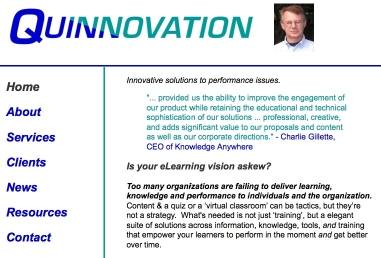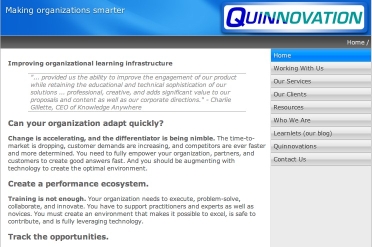Previous Series Post |Next Series Post
This is one in a series of thoughts on some broken areas of ID that I‘m posting for Mondays. I intend to provide insight into many ways much of instructional design fails, and some pointers to avoid the problems. The point is not to say ‘bad designer‘, but instead to point out how to do good design.
I see several reliable problems with examples, and they aren‘t even the deepest problems. They tend to be mixed in with the concept, instead of separate, if they exist at all. Then, when they do exist, too often they‘re cookie-cutter examples, that don‘t delve into the necessary elements that make examples successful, let alone are intrinsically interesting, yet we know what these elements are!
Conceptually, examples are applications of the concept in a context. That is, we have a problem in a particular setting, and we want to use the model as a guide to solving the problem. Note that the choice of examples is important. The broader the transfer space, that is, the more general the skills, the more you want examples that differ in many respects. Learners generalize the concept from the examples, and the extent to which they‘ll generalize to all appropriate situations depends on the breadth of contexts they‘ve seen (across both examples and practice). You need to ensure that the contexts the learner sees are as broadly disparate as possible.
Note that we should also be choosing problems and contexts that are of interest to the audience. Going beyond just the cognitive role, we should be trying to tap into the motivational and engagement factors. Factor that into the example design as well!
Now, we know that examples have to show the steps that were taken. They have to have specific steps from beginning to end. And, I add, those steps have to refer back to the concept that guides the presentation. You can‘t just say “first you do this, then you do thisâ€, etc, you have to say “first, using the model, you do this, and then the model says to do thatâ€. You need to show the steps, and the intermediate work products. Annotating them is really important.
And that annotation is not just the steps, but also the underlying thought processes. The problem is, experts don‘t even have access to their thought processes anymore! Yet, their thinking really works along lines like “well, I could‘ve done A, but because of X, and thought B was a better approach, and then I could do C, but because of Y I tried Dâ€, etc. The point being, there‘s a lot of contextual clues that they evaluate that aren‘t even conscious, yet these clues are really important for learners. (BTW, this is one of the many reasons I recommend comics in elearning, thought bubbles are great for cognitive annotation.)
Another valuable component is showing mistakes and backtracking. This is a hard one to get your mind around, and yet it‘s powerful both cognitively and emotionally. First, experts model the behavior perfectly, and when learners try, they make mistakes, and may turn off emotionally (“I‘m having trouble, and it looks so easy, I must not be good at thisâ€). In reality, experts make mistakes all the time, and learners need to know that. It keeps you from losing them altogether!
Cognitively it‘s valuable, too. When experts show backtracking and repair, they‘re modeling the meta-skills that are part of the expertise. Unpacking that self-monitoring helps learners internalize the ‘check your answer‘ component that‘s part of expert performance. This takes more work on the part of the designer, like we had with the concept, but if the content is important (otherwise, why are you building a course), it‘s worth doing right.
Finally, I believe it‘s important to convey the example as a story. Our brains are wired to comprehend stories, and a good narrative has better uptake. Having a protagonist documenting the context and problem, and then solving it with the model to achieve meaningful outcomes, is more interesting, and consequently more memorable. We can use a variety of media to tell stories, from prose, through audio (think mobile and podcasts) and narrated slideshow, animation, or video. Comics are another channel. Stories also are useful for conveying the underlying thought processes, via thought bubbles or reflective narration (“What was I thinking?…â€).
So, please do good examples. Be exemplary!

